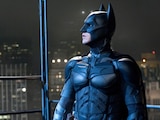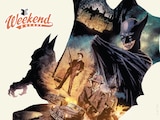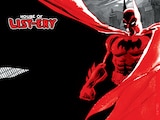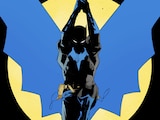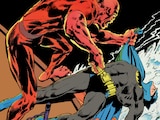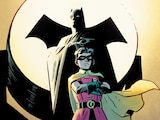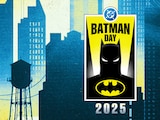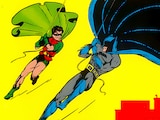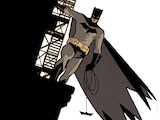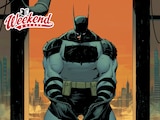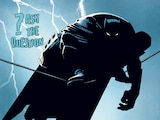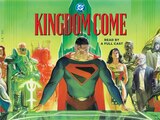Hello. I’m Alex Jaffe, better known in the DC Community as HubCityQuestion. My personal mission: to take on any question you have about the DC Universe—no matter how strange, granular, or obscure—and present you with an answer. As a faithful steward of the truth, I offer my time in this monthly column to address these inquiries. If you’d like to submit a question of your own, you can stop by my virtual office over in the Community at any time to state your case. I’ll do my best to address them all to the best of my ability.
All right, let’s get some answers!
Faster Than a Speeding Bullet

Detectiveomen5.93194 asks:
In (the animated films Batman: Under the Red Hood and) Batman: Death in the Family, Robin says, "twenty rounds a second and you’re still too slow." How fast would Jason need to be moving in this moment?
Well, answering this one requires me to be many things I am not, one of which is a mathematician. But I’ll go ahead and give it my best shot.
First, let's answer this question literally, by seeing how fast Jason would need to be moving in order to get out of the way of the bullet when it was fired. This math could potentially be pretty tricky...air resistance calculations in particular can be a pain. But fortunately, after searching around on my Batcomputer, it seems like air resistance is negligible over these short distances, which makes our math pretty easy. All we need is:
- The distance Jason has to travel to get out of the way (in meters), times speed of the bullet (in meters per second), divided by the distance the bullet will travel (also in meters.)
We can ignore the parabolic arc of projectiles for these purposes, because it doesn't really matter where in Jason's chest the bullet would hypothetically hit, and it won't fall that much over these distances.

Now, how far does Jason need to travel to get out of the way? Let's consider the worst-case scenario, where the bullet is aimed directly at the center of his chest. In this case, he'd need to move to the left or right by at most half of his shoulder width. So that's:
- <One half Jason's shoulder width> (m) times the speed of the bullet (m/s) divided by distance the bullet will travel (m).
So far, the math isn't too bad. The problem now is what numbers to fill in for any of these.
Let's start with the speed of the bullet. How fast is the bullet traveling? Well, the average bullet travels around 2,736 Kilometers/hour or 1,700 miles per hour, but the speed of this gun is specifically given as "twenty rounds a second." A person who knows more about guns than I do might be able to identify the specific model of gun from the clip in this movie and get the bullet speed that matches it. But for now, we'll just go with the average. Plugging 2,736 kilometers per hour = 760 m/s into this equation would give us:
- One half Jason’s shoulder width * <760 m/s> / distance the bullet will travel (m).

Now, how far away from the bullet is Jason? I’m no draftsman, but I happen to know a few. I showed the clip to my friend Walt, and he said it looked like a distance of about ten feet, or roughly three meters. That makes for easy math. So that gives us:
- One half Jason’s shoulder width * <760 m/s> / <3>.
Time for our third estimate here. How wide are Jason's shoulders? Well, the Death in the Family movie tells us this happened shortly before Jason's death, so we'd be looking for a canonical measurement from around that time. The closest we can get to that is an estimate from 1986’s Who’s Who #19, a post-Crisis book which still uses Jason's pre-Crisis origin, which lists him as 5'2". That seems kind of short to me, but it's the best textual measurement we've got. So that makes Jason about 158 centimeters tall (we'll round up a bit, since this estimate is already a bit on the short side for later in Jason's career). If I'm using this proportionality constant calculator correctly, we're looking at about 40.9 centimeters, or 0.409 meters.
So all together, that gives us <0.409m> * <760m/s> / <3m>, or roughly 103.6 m/s. Which makes for about 231.7 miles per hour.

This is assuming that Jason is moving to the side to get out of the way, rather than turning. What would it look like if he were turning? Well, the question specifically asked how fast Jason would need to be moving in this moment, so that question is only arguable in scope, but it's kind of a moot point, as I unfortunately can't find any good numbers on how fast the human body can twist in place. If anyone knows where to find them, let me know and I can give you some numbers for the torque! I'm pretty sure, though, that the answer is not going to be particularly reasonable, either.
However, it's a pretty safe bet that Jason is not, in fact, dodging bullets like he's in The Matrix. (Now streaming on HBO Max!) I mean, pop that video in and watch the scene again. Don’t take Jason’s word for gospel here, that thug is clearly firing above Jason. He’s just trying to keep Robin away with suppressing fire. Gotham may be a rough city, but that doesn’t mean every gangster in town is just going to gun down a kid on sight.
Let Them Fight

tevyasmolka.8908 asks:
Do you think we will get a Super Sons animated movie? Because that would be fun.
Full disclosure: I first received this question in August 2019. My answer, at least privately, was yes, I did believe we would eventually get an animated film based on the super popular team-up of the sons of Batman and Superman, Damian Wayne and Jon Kent. Finally, at this year’s DC FanDome, my instincts were proven true! So yes, I do think we will get a Super Sons animated movie. I also think it will debut in 2022, that it will be Warner Bros. Animation’s first full CGI film, and that it will be titled Battle of the Super Sons. My money’s on Jon.
No Man (or Martian) Escapes

BrodieIsGod asks:
Is there any connection between the Green Lantern villains the Manhunters, the heroes the Manhunters, and the Martian Manhunter?
Before we get into the history of DC’s various “Manhunters,” a little history on the word itself. Although it’s fallen from common usage, “manhunter” has been used to describe, well, a hunter of men since the 15th century at least. First associated with killers and cannibals, the term was eventually used to describe pursuers of justice, retribution, or bounty. There was a silent Western film in 1919 called The Man Hunter, a Man Hunter film in the Rin-Tin-Tin dog movie franchise in 1930, a 1974 TV series starring Ken Howard as the Manhunter, a German cannibal exploitation film in 1980, a 1986 Michael Mann film in the Hannibal Lecter series, a 2005 British TV drama, and a 2008 American reality show. Even Batman himself is referred to as the “Masked Manhunter” at times in Bronze Age-era Detective Comics. So in one sense, trying to unify every hero to go by “Manhunter” is a lot like trying to find a connection between every hero called “Captain.”
But that’s not to say attempts have not been made. First, we should note that the human line of Manhunters, at least in terms of real-world publication history, is significantly older than the Green Lantern enemies. The first Manhunter, Paul Kirk, debuted in 1940’s Adventure Comics #58. Originally, Kirk was not a costumed hero, but a private detective who was only ever called “Manhunter” in the feature’s title, as detectives of the time often were. Eventually, Paul Kirk was conflated with another, more superheroic “Manhunter” created by Jack Kirby and Joe Simon named Rick Nelson, and today the two are considered one and the same. At the same time that Paul Kirk’s adventures were running in Adventure Comics, rival publisher Quality Comics had introduced a Manhunter of their own, Dan Richards, who would eventually be acquired by DC along with the rest of Quality’s characters, like Plastic Man and the Freedom Fighters. Issues of All-Star Squadron in the ’80s would eventually re-establish Kirk and Richards as contemporaries.

In the 1970s, Kirby returned to DC after an extended absence. As part of his stay, he revisited the Manhunter concept with a new hero named Mark Shaw, who was inducted into an ancient crimefighting cult calling themselves the Manhunters—and who wore a costume which would eventually be used by the now infamous Green Lantern villains.
Those villains originally debuted in 1977’s Justice League of America #140, which explored the origins of the Manhunter cult for the first time as an ancient order of interstellar police, for which men like Paul Kirk and Mark Shaw were chosen as emissaries. Although considered to be eradicated by the Guardians of the Universe eons ago, these cybernetic Manhunters continued to operate through the universe via proxies on civilizations throughout the universe. Just as the cybernetic Manhunters deputized humans to govern Earth, so too were they said to be responsible for the order of Martian Manhunters, of which the Justice League’s J’onn J’onzz was the last.

If this sounds like the makings of a “Crisis” level event to you, the comics are way ahead of you. The activation of these sleeper agents formed the backbone of 1988’s “Millennium” crossover, which ran through nearly every DC comic at the time. Read through any DC book from the late eighties and you’re bound to find a reference to it somewhere.
JLAncient

TurokSonOfStone1950 asks:
I remember a panel where the original Egyptian versions of Hawkman and Hawkgirl assemble a group to fight against some villain. The others were Nabu, Black Adam and that era’s Metamorpho. What was the issue, and what villain?
I believe the arc you’re looking for is 2002’s “JSA B.C.”, featured in JSA #43-44. That era’s Metamorpho whom you’re recalling, the priest Ahk-Ton, was in fact one of the two villains that the ancient heroes assembled to fight. The other was…who else? Vandal Savage.
All This and Brains, Too

thejls asks:
Were older versions of Superman “smarter”?
I seem to remember something in the main universe canon about his Kryptonian physiology giving him perfect recall and allowing his brain to process information faster than a human. However, the only feat of intelligence I can remember in recent times was him reading some medical journals and performing open-heart surgery with his fingernail (I think this was in Grant Morrison’s New 52 Action Comics run).
Are there any other canon examples of main universe Superman being a genius? Which version of Superman showed the most intelligence?
“Super intelligence” is among the least demonstrated of Superman’s powers, but it’s one which writers do remember to bring up from time-to-time. In the Silver Age, it was Superman’s “super-memory” which allowed him to recall his own birth and the destruction of Krypton. Kryptonian super-intelligence was similarly given as the reason that Krypto, when exposed to our yellow sun, could think and reason on a human level. Throughout Pre-Crisis comics, we see Superman continuing his father Jor-El’s work as a scientist and inventor, constantly tinkering with projects in his Fortress of Solitude.

Morrison, as you mentioned, is probably the most likely modern Superman writer to utilize “super intelligence,” from absorbing every text in a medical library, to performing complex interstellar calculations faster than a super-computer. The most impressively intelligent Superman, in fact, is likely Morrison’s own in All-Star Superman, who creates an entire universe in miniature as one of his final feats on Earth.
That said, I personally don’t quite care for when Superman is able to super-think everyone. It’s like letting him run faster than the Flash, you know? Let some other members of the Justice League do some stuff better. But who asked for my opinion? Well, that’s the kind of editorializing one must occasionally endure in exchange for answers when you ASK…THE QUESTION.
Got something that's keeping you up nights? If you have a question about the DC Universe that you'd love to get answered, you can head on over to the DC Community and ask it here.
Alex Jaffe is the author of our monthly "Ask the Question" column and writes about TV, movies, comics and superhero history for DCComics.com. Follow him on Twitter at @AlexJaffe and find him in the DC Community as HubCityQuestion.
NOTE: The views and opinions expressed in this column are solely those of Alex Jaffe and do not necessarily reflect those of DC Entertainment or Warner Bros.

